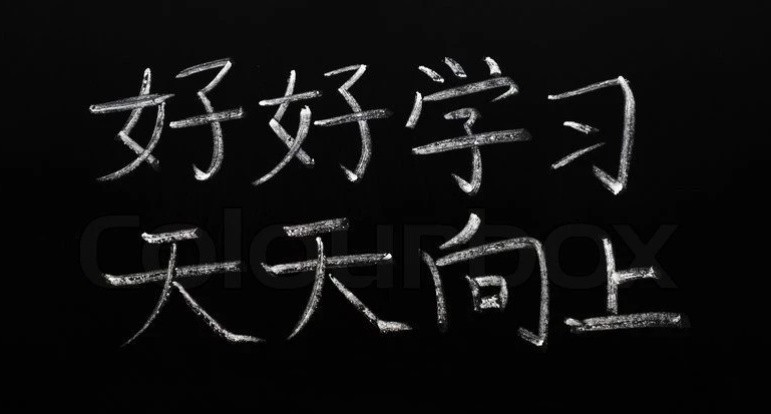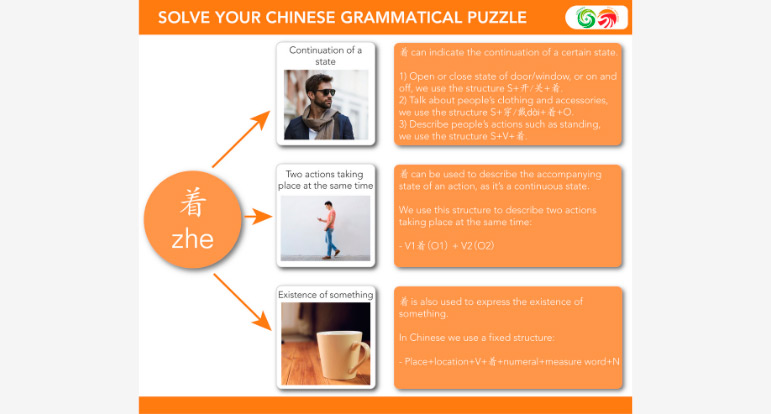Nov.12, 2019
Yes, "着 zhe" is like a grammar point lying in the textbook. After you studied it, you close the textbook and finish the class, probably "着 zhe" is still there. You never know where and when to use it, as it seems to have nothing to do with sounding like a native speaker. But this is not true!
Today, in this post, we gonna make you see that "着 zhe" indeed is important and we will add it to your daily life talking!
Let me explain one by one here:
1. When we want to properly describe the steady state of the door being closed or opened or the TV being switched on or off, in that case we add 着 to the verb. For instance:
他可能在办公室。门关着。
Tā kěnéng zài bàngōngshì。Mén guān zhe。
He's probably at the office. The door is closed.
电视开着,但是家里没人。
Diànshì kāi zhe,dànshì jiā li méi rén。
The TV is on, but nobody is at home.
2. In the same way, we use "着" to talk about people's clothing and accessories:
我很喜欢他穿着的那件蓝衬衫。
Wǒ hěn xǐhuān tā chuān zhe de nà jiàn lán chènshān。
I like that blue shirt that he is wearing.
Please note that the English translation: "be + …ing", is perfectly expressing the meaning of "着" namely that of a steady state, right?
她戴着一条白围巾,气色很好。
Tā dài zhe yì tiáo bái wéijīn, qìsè hěn hǎo。
She is wearing a white scarf and it looks very good.
3. When we describe people undertaking simultaneous actions we also use "着 zhe" a lot. For example:
他一直在院子里站着等孩子考试回来。
Tā yìzhí zài yuànzi lǐ zhàn zhe děng háizi kǎoshì huí lai.
He is standing in the yard, waiting for the kid to come back from the exam.
The usage of "着" here is easy to understand if you distinguish between the "steady state" action and the "active" action, or you might say the "background" action and the "foreground" action which can be considered as his main action. The background action here is "standing in the yard" and his main action is that he is waiting for his kid. Not so hard anymore right?
Here are some more examples, have a look at the picture:

Their main actions here are riding, walking and driving, but meanwhile, in the background, they are all watching their phones. Translating the next examples as we did here will further help you to understand:
他看着手机走路。
Tā kàn zhe shǒujī zǒulù。
He walks while watching the phone.
The other people in this picture are:
他看着手机开车。
Tā kàn zhe shǒujī kāichē。
He drives while watching the phone.
他看着手机骑自行车。
Kàn zhe shǒujī qí zìxíngchē。
He rides bicycle while watching the phone.
4. Last but not least, "着" is also often used to express existence, to express that something is there, something is present. How would you describe the picture above in English? You would use "there be", right?
There is a mug on the table.
In Chinese, we say:
桌子上放着一个杯子。
Zhuōzi shang fàng zhe yíge bēizi。
"着" is put after the verb to indicate the continuous state.
How to describe this?

黑板上写着一些汉字。
Hēibǎn shang xiě zhe yìxiē hànzi。
There are some characters written on the blackboard.
These are most of the common scenarios that you could apply "着".
You got it? Don't avoid using this particle next time!
Here's a small task for you to test yourself if you fully understand "着":
Write three sentences in the comment with "着zhe" to describe this room. I will check and write back to you!

Most Popular Posts
